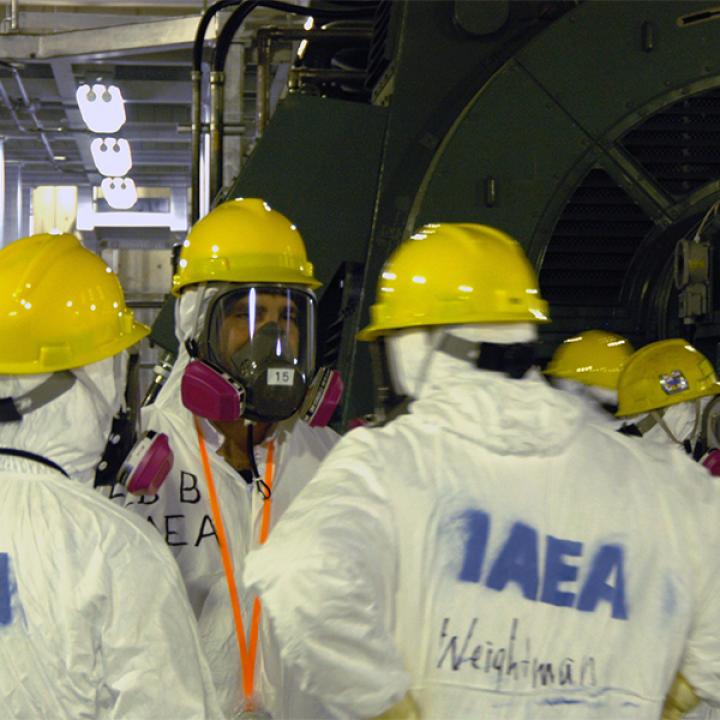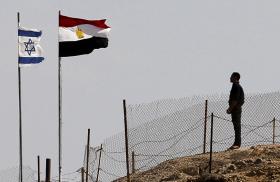
- Policy Analysis
- PolicyWatch 3849
Washington and Europe Need to Get on the Same Page Regarding Iran’s Nuclear Progress

The latest IAEA report shows why the West must refocus on Tehran’s nuclear program, which continues to expand even as international will to address it seemingly declines.
Proxy militia strikes across the Middle East are not the only escalation that Iran has set in motion since the October 7 Hamas attack on Israel—the regime has also escalated its nuclear activities at home. These nuclear strides coincide with Tehran’s sharper hardline turn in domestic politics, its growing disregard for U.S. warnings, and its increasing alignment with Russia and China, as exemplified by its surging sales of oil to Beijing and military hardware to Moscow.
In response, U.S. regional partners have been hedging their bets—Saudi Arabia and the United Arab Emirates normalized relations with Tehran and bolstered ties with China and Russia, while Riyadh redoubled its interest in both a civil nuclear program and a U.S. defense treaty. These actions are driven at least in part by the lackluster U.S. and European responses to Iran’s escalation, including modest, uncoordinated statements about the nuclear issue and indecisive reactions to proxy militia attacks. If Iran is to be dissuaded from steaming toward nuclear weapons, Washington and its partners will need to take a firmer, more united approach.
Latest Nuclear Advances
At first blush, the headline out of the latest report from the International Atomic Energy Agency (IAEA) may sound encouraging: Iran decreased its stockpile of 60% enriched uranium during the November 2023-February 2024 reporting period. (For an explanation of enrichment terminology, see this Washington Institute infographic or the associated Iran Nuclear Glossary.) Yet this finding obscured the larger picture, which was anything but rosy.
In reality, Iran increased its overall stockpile of enriched material and more than doubled its production rate for 60% uranium. The decrease in its 60% stockpile occurred because Tehran simultaneously “downblended” some of this material to 20%, creating a large reservoir of material that can be boosted back up to 60% or higher relatively quickly given the regime’s increased deployment of advanced centrifuges. The net effect of these steps is that Iran can now produce sufficient weapons-grade uranium (WGU) for a single nuclear bomb in just a week, and enough for seven weapons in a month. Put another way, it could produce enough material for a bomb before inspectors detected this effort.
To be sure, Iran would need more time—around six months by some estimates—to turn that WGU into a usable weapon. But this should provide little comfort to policymakers. Alongside its nuclear advances, Tehran has been steadily decreasing its cooperation with the IAEA. It has refused to provide credible answers to the agency’s questions about undeclared nuclear activities at suspected nuclear sites, including several revealed by the “nuclear archives” that Israeli agents spirited out of the Islamic Republic in 2018. It has also “de-designated” veteran IAEA investigators and failed to notify the agency in advance about the construction of a new nuclear facility. This is particularly worrisome given that another new facility—this one deeply buried near Natanz—could be used for nuclear weapons-related work.
Given all these factors—the size of Iran’s uranium stockpile, the sophistication of its enrichment capabilities, its diminishing cooperation with the IAEA, and its preexisting weaponization work—the United States and other actors may not have enough notice to prevent the regime from producing a workable nuclear weapon if Tehran decides to take that path. Iran’s growing secrecy might also cloud the U.S. intelligence picture, making it difficult for analysts to provide the president with precise warnings about the regime’s nuclear activities and intentions. Of course, Tehran may choose to remain at the nuclear weapons threshold rather than cross it. Yet Iranian leaders might just as readily be emboldened by their success in stonewalling inspectors, expanding the program relatively unhindered, and cementing their hardline grip at home after cracking down on mass protests. In that scenario, Iran may decide to press forward and become the world’s tenth nuclear weapons state.
Insufficient Western Responses
The latest IAEA report issued several stark warnings. Repeating one of the agency’s most sobering past assessments, it stated that officials have “lost continuity of knowledge in relation to the production and inventory of centrifuges, rotors and bellows, heavy water and uranium ore concentrate,” noting that the IAEA would likely struggle to provide a clear picture of Iran’s nuclear activities even if cooperation were restored. An accompanying report also emphasized a new concern: “Public statements made in Iran regarding its technical capabilities to produce nuclear weapons only increase the Director General’s concerns about the correctness and completeness of Iran’s safeguards declarations.” The “statements” in question are likely the public boasts made in early February by former Iranian nuclear chief Ali Akbar Salehi, who claimed that the regime already has all the components it needs for a nuclear weapon but simply has not put them together.
Tehran’s confidence stems in part from the fact that the United States and its E3 partners Britain, France, and Germany have not reacted assertively to the IAEA’s repeated warnings. After the agency’s previous report last year, they largely limited themselves to declaring that Iran must resume cooperation with inspectors, roll back its enrichment of 60% uranium, and comply with the Joint Comprehensive Plan of Action (JCPOA). The latest report makes clear that Iran has failed to take any of these steps. Yet the United States and E3 have once again responded with seemingly uncoordinated verbal warnings alone, albeit more concrete ones.
Specifically, the E3 stated, “In the absence of decisive and substantive progress, the [IAEA Board of Governors] must be prepared to adopt another resolution at its next meeting, and to consider future action as necessary.” Washington offered a similarly muted response, noting that it would request a “comprehensive summary report” on Iran’s violations of its IAEA Safeguards Agreement if no progress is made. (Such a summary would presumably resemble the one issued in December 2015 regarding Iran’s suspected nuclear weapons work.) Notably, the United States and Iran held secret talks in January that may have touched on the nuclear issue; if so, these conversations did not yield Iranian restraint.
As in the past, the U.S. and E3 statements were issued separately and warned of different measures, suggesting a transatlantic gap on the nuclear issue. The partners are certainly capable of showing unity of purpose on Iran, as seen in the G7’s March 15 statement warning the regime that “new and significant” measures would be taken if it transfers ballistic missiles to Russia. Their lack of coordination on the nuclear issue shows how much it has declined as a priority amid mutual concerns on several fronts, including the wars in Ukraine and Gaza, the potential for a clash with China over Taiwan, and the increasingly scant and unpalatable policy options as Iran’s breakout time shrinks. Yet by sidelining the issue and presenting a divided front, they risk further emboldening those elements in Tehran who may believe the regime can produce nuclear weapons without provoking a catastrophic Western response. Continued Western disunity could also lead discouraged regional partners to pursue additional hedging strategies, including in the nuclear realm.
Next Steps
To deter Iran from further nuclear weapons-related activities, the Biden administration and its E3 partners should consider a series of joint actions. In addition to imposing more palpable costs on Tehran, these measures may be the only way to avoid a fateful decision about potential military strikes on Iran.
Diplomatic:
- Adopt a resolution at the next IAEA Board meeting censuring Iran for its failure to cooperate with the agency or meet its obligations under the Nuclear Nonproliferation Treaty.
- Ask the IAEA to produce a comprehensive report summarizing Tehran’s safeguards violations, and use this document as a basis to refer Iran to the UN Security Council for action.
- Urge E3 officials to either exercise the JCPOA’s “snapback” provision or warn that they will not let the provision expire as scheduled in October 2025 unless Iran rolls back its nuclear activities.
- Publicize the fact that the United States, E3, and other partners are jointly and actively engaged in contingency planning for a possible Iranian nuclear breakout.
Economic:
- Enforce existing sanctions against Iran, particularly those targeting its oil exports, which have rebounded to pre-sanctions levels in recent months.
Military:
- Warn that the United States is prepared to take military action if necessary to prevent Iran from obtaining a nuclear weapon. The administration should ask the Trump campaign to issue a similar statement to make clear this is a matter of bipartisan consensus.
- Back up this military threat with firmer action against Iranian activities that support the recent escalation by its regional proxies. This includes targeting Iranian spy vessels that facilitate Yemeni Houthi attacks on commercial ships in the Red Sea and Gulf of Aden.
Michael Singh is the managing director and Lane-Swig Senior Fellow at The Washington Institute.



